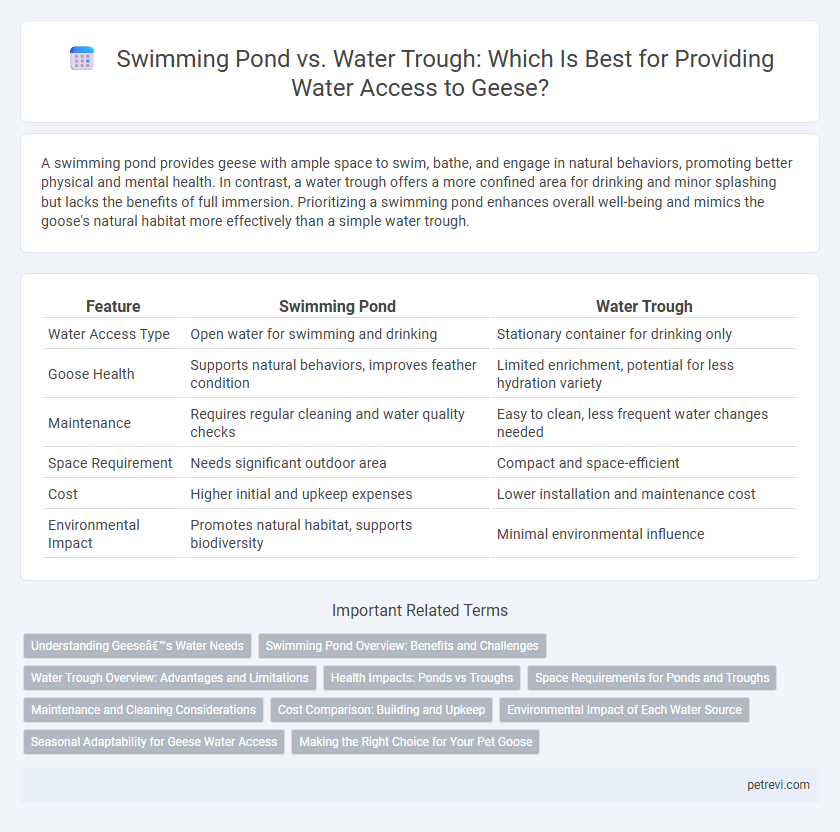A swimming pond provides geese with ample space to swim, bathe, and engage in natural behaviors, promoting better physical and mental health. In contrast, a water trough offers a more confined area for drinking and minor splashing but lacks the benefits of full immersion. Prioritizing a swimming pond enhances overall well-being and mimics the goose's natural habitat more effectively than a simple water trough.
Table of Comparison
| Feature | Swimming Pond | Water Trough |
|---|---|---|
| Water Access Type | Open water for swimming and drinking | Stationary container for drinking only |
| Goose Health | Supports natural behaviors, improves feather condition | Limited enrichment, potential for less hydration variety |
| Maintenance | Requires regular cleaning and water quality checks | Easy to clean, less frequent water changes needed |
| Space Requirement | Needs significant outdoor area | Compact and space-efficient |
| Cost | Higher initial and upkeep expenses | Lower installation and maintenance cost |
| Environmental Impact | Promotes natural habitat, supports biodiversity | Minimal environmental influence |
Understanding Geese’s Water Needs
Geese require access to clean, fresh water for hydration, preening, and maintaining feather health, making swimming ponds ideal compared to water troughs. Swimming ponds provide ample space for natural behaviors like dabbling and swimming, which support their physical and psychological well-being. Water troughs, while practical, often lack sufficient depth and surface area, limiting geese's ability to fully engage in essential water activities.
Swimming Pond Overview: Benefits and Challenges
A swimming pond offers geese ample space for natural behaviors like swimming, preening, and socializing, promoting better physical health and mental well-being. The pond's natural filtration system and variable depths help keep the water cleaner while providing diverse habitat zones, but maintenance can be labor-intensive and requires regular monitoring to prevent algae overgrowth and water contamination. Challenges include managing water quality during seasonal changes and ensuring safety from predators, making swimming ponds a balanced choice for sustainable goose water access.
Water Trough Overview: Advantages and Limitations
Water troughs provide geese with a consistent and easily accessible water source, promoting hydration and hygiene by reducing mud and contamination common in natural ponds. Their controlled design limits waterborne pathogens but requires regular cleaning to prevent algae buildup and bacterial growth. However, water troughs lack the natural environment benefits of swimming ponds, such as exercise and behavioral enrichment.
Health Impacts: Ponds vs Troughs
Swimming ponds provide geese with natural water environments that support their grooming and feather maintenance, reducing the risk of skin infections and improving overall health. Water troughs, while easier to clean and control, may limit these natural behaviors, potentially increasing stress and vulnerability to parasites. Access to a clean, adequately sized swimming pond is often linked to healthier geese with better plumage condition compared to exclusive use of water troughs.
Space Requirements for Ponds and Troughs
Swimming ponds require significantly more space than water troughs, with ideal pond sizes ranging from 100 to 500 square feet to allow natural swimming and preening behaviors. Water troughs, on the other hand, need minimal space, typically around 2 to 4 square feet, making them suitable for smaller areas or confined enclosures. Proper pond dimensions ensure adequate water depth and surface area to support a healthy environment, while troughs prioritize accessibility and ease of maintenance in limited spaces.
Maintenance and Cleaning Considerations
A swimming pond offers a natural, spacious water source for geese but requires regular maintenance to prevent algae buildup and debris accumulation, which can impact water quality and bird health. Water troughs are easier to clean due to their smaller size and controlled environment, allowing for frequent water changes and reduced risk of contamination. Choosing between the two depends on balancing maintenance effort, space availability, and ensuring consistent access to clean drinking water for optimal goose welfare.
Cost Comparison: Building and Upkeep
Building a swimming pond for geese involves higher initial costs due to excavation, lining, and landscaping compared to installing a water trough, which is relatively inexpensive and simple to set up. Maintenance expenses for a swimming pond include regular cleaning, water treatment, and potential repairs, while water trough upkeep mainly consists of periodic cleaning and refilling. Overall, water troughs offer a more cost-effective solution for providing geese with water access, especially in smaller-scale or budget-conscious setups.
Environmental Impact of Each Water Source
Swimming ponds provide geese with natural filtration systems that reduce pollutants and support aquatic ecosystems, promoting biodiversity and healthier water quality. Water troughs often require regular cleaning and chemical treatments, which can lead to runoff contamination and disrupt local soil conditions. Sustainable management of swimming ponds minimizes habitat disturbance and carbon footprint, making them a more environmentally favorable option for goose water access.
Seasonal Adaptability for Geese Water Access
Swimming ponds provide geese with natural behaviors such as swimming and foraging, especially beneficial during warmer months when water access is vital for hydration and thermoregulation. Water troughs offer a consistent, clean water source unaffected by freezing temperatures, ensuring geese have reliable access during winter and early spring. Seasonal adaptability favors a combination approach, using swimming ponds in summer and water troughs in colder seasons to meet geese's water needs year-round.
Making the Right Choice for Your Pet Goose
Choosing between a swimming pond and a water trough for your pet goose depends on their natural behavior and health needs; swimming ponds provide a natural environment for bathing and exercise, promoting feather condition and overall well-being. Water troughs offer easier maintenance and cleaner water, reducing the risk of contamination and diseases like avian influenza. Assessing space availability, water quality, and ease of cleaning helps ensure the best water access option tailored to your goose's lifestyle and health requirements.
Swimming Pond vs Water Trough for Goose Water Access Infographic

 petrevi.com
petrevi.com